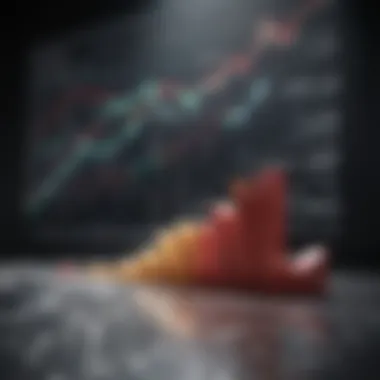Analyzing the Causes of Today's Market Decline


Intro
In the ever-shifting landscape of finance, understanding the nuances behind market movements becomes critical. Today, we find ourselves grappling with a significant market decline that has left many investors pondering their next steps. The factors contributing to this downturn are complex and varied, deeply rooted in economic indicators, geopolitical tensions, and intrinsic market traits. Ignoring these elements could lead to hasty decisions that might leave investors regretting their choices.
As the saying goes, "Don’t put all your eggs in one basket," and this holds true in volatile times like these. A thorough examination of the elements at play can illuminate pathways for informed investment decisions. The following sections will provide a comprehensive understanding of the current market dynamics, equipping individual investors and financial enthusiasts with insights tailored for today’s challenges.
Overview of Financial Products
Definition and Significance
At its core, financial products serve as instruments through which investments, savings, and capital growth manifest. They are not simply trading tools, but represent various opportunities for individuals to engage with market fluctuations. Understanding these products can help investors navigate challenging waters more effectively.
Types of Financial Products Available
Today’s market offers a smorgasbord of financial products, each catering to different investment goals and risk appetites. Some of these include:
- Stocks: Represent ownership in a company. They can yield high returns but come with considerable risks associated with market volatility.
- Bonds: Provide fixed interest over time and are generally safer than stocks, making them a staple in conservative portfolios.
- Mutual Funds and ETFs: Allow investors to pool money, diversifying investments across multiple assets, which can reduce risk.
- Options and Derivatives: These complex financial instruments can amplify profits, but they come laden with risks that can lead to significant losses.
- Real Estate Investment Trusts (REITs): Offer a way to invest in real estate without needing to manage physical property, but they can also be influenced by market downturns.
Key Attributes
Interest Rates and Returns
Most financial products have certain characteristics that smart investors need to be aware of, particularly interest rates. For instance, the relationship between bonds and interest rates can significantly impact overall returns. Generally, as interest rates increase, bond prices decline, leading to potential losses for bondholders.
Risk Factors Associated with Each Product
Understanding risk is integral to any investment strategy. The types of risks vary:
- Market Risk: Present across all investments; a decline in market conditions can lead to capital loss.
- Credit Risk: Particularly pertinent to bonds, where the issuer might default on payments.
- Liquidity Risk: The difficulty in converting an investment back into cash without significant loss.
- Operational Risk: Arises from failures in internal processes, people, or systems—important for complex products like derivatives.
"Investors need to be aware that with potential reward comes potential risk, and none is insulated from market influences."
With a clearer insight into financial products and their underlying attributes, investors can formulate strategies that address market conditions more methodically. The following sections will delve deeper into how various economic indicators and geopolitical dramas are currently affecting market performance.
Market Overview
Understanding the current market dynamics is critical for investors looking to navigate through today's financial landscape. The market overview lays the groundwork for comprehending the various forces at play. It provides a snapshot of where we stand, outlining the trends and historical context that form the backbone of current situations. By closely examining these elements, individuals can better assess possible outcomes and devise strategies for risk management.
In today’s fast-paced environment, acknowledging how market behavior transforms over time is crucial. This overview not only highlights present conditions but also sets the stage for subsequent discussions, such as the economic indicators and geopolitical factors influencing market health.
Current Market Trends
Today’s market is rife with unpredictability, and it shows evident signs of volatility. Stocks have been fluctuating like leaves in the wind, influenced by a mixture of economic news, corporate earnings, and international happenings. These currents impact investor behavior and market confidence.
For instance, take a look at how technology stocks have recently faced pressure after years of rapid growth. Companies like Amazon and Tesla that once soared have seen their valuations reassessed. Investors are increasingly cautious, reacting to inflation data and comments from Federal Reserve officials regarding interest rates. This cautious sentiment reflects a broader apprehension about sustainability in economic growth.
One critical trend emerging is the transition towards more defensive investment strategies. Investors are reevaluating portfolios, leaning more towards staples and utilities rather than more volatile sectors. This inclination exhibits a mindset shift, highlighting the pressing nature of market conditions.
Historical Context
To truly grasp the current market, one must dive into its past. History often provides many counterpoints that echo through market trends. For instance, the financial crisis of 2008 serves as a pointed reminder of how quickly gains can evaporate. In times of market stress, parallels to past events can help investors frame their strategies.
Analyzing historical market cycles shows a tendency towards corrections after prolonged growth periods. Such corrections can be sharp, just as they can be gradual. The dot-com bubble at the turn of the century showcases how overexuberance can lead to serious reevaluations. Likewise, the recent pandemic spurred rapid shifts in consumer behavior, but this too was followed by a readjustment as the world returned to a semblance of normalcy.
Understanding these patterns can empower investors as they reflect on current conditions. Coming to terms with the cyclical nature of markets prepares one for potential dips and recoveries, allowing for more informed decisions. It’s about reading the waves while knowing that calm seas can quickly turn turbulent.
"Those who do not remember the past are condemned to repeat it." - George Santayana
In short, the interplay of current trends and historical context provides a necessary backdrop in our quest to understand today’s market decline.
Economic Indicators
Understanding economic indicators is crucial to grasp the nuances of today’s market decline. These indicators offer a snapshot of the economic landscape, revealing underlying trends that impact market performance. Investors often rely on these metrics to inform their decisions, as they provide insights into the health and trajectory of the economy. Ignoring them can be like sailing without a compass in turbulent waters.
Inflation Rates
Inflation rates are a key aspect of economic indicators, reflecting the pace at which prices for goods and services rise. When inflation soars, purchasing power diminishes, causing consumers to tighten their belts. This shift often leads to decreased spending, which in turn can trigger a chain reaction detrimental to businesses and the stock market. Investors should consider the Consumer Price Index (CPI) and the Personal Consumption Expenditures (PCE) index to gauge inflation trends. "If prices keep climbing, folks won't be buying much more than necessities."
- Consider the following:
- A steep rise in inflation can lead the Federal Reserve to increase interest rates, making borrowing costlier.
- Higher interest rates can dampen business investment and consumer spending, further exacerbating economic downturns.
Unemployment Statistics
Unemployment statistics, encompassing the unemployment rate and job creation figures, serve as vital clues to the market’s direction. A rising unemployment rate usually signals distress in the job market, leaving people with less disposable income to spend, which can have a ripple effect throughout the economy. When too many folks are out of work, overall demand dwindles, leading to lower revenue for companies and, ultimately, declining stock prices.


"When jobs vanish, so do consumer bucks. It’s as simple as that."
- Key points to note:
- Keeping an eye on the Non-Farm Payroll (NFP) report can provide insight into how many jobs were added or lost each month.
- A quick jump in unemployment may indicate larger economic issues lurking just below the surface.
GDP Growth Rates
Gross Domestic Product (GDP) growth rates are often touted as the best measure of an economy’s health. A persistent decline in GDP can signal an impending recession, which frightens investors and prompts them to reevaluate their positions. In contrast, robust GDP growth fosters confidence, encouraging investment. GDP contraction can spell trouble, leading to tighter financial conditions and cautious consumer behavior.
- Remember these insights:
- Real GDP accounts for inflation, providing a clearer picture of actual growth.
- Analyzing quarter-over-quarter changes can pinpoint trends that signals shifts in the economic cycle.
In short, examining these economic indicators is essential for any investor looking to navigate today’s turbulent market. By paying attention to inflation rates, unemployment statistics, and GDP growth, one can better understand the forces at play and make more informed decisions amid uncertainty.
Geopolitical Factors
In today’s marketplace, the influence of geopolitical factors cannot be overstated. When we talk about the market’s ups and downs, we must take into account how international relationships, conflicts, and policy decisions impact investor confidence and overall economic stability. A ripple in one part of the world can create waves far beyond its shores, rippling through markets and affecting decisions by investors everywhere.
International Conflicts
International conflicts have a significant sway over market dynamics. When hostilities break out—be it a war, territorial disputes, or even simple diplomatic tensions—investors often react like a deer caught in headlights. These conflicts can create uncertainty that can lead to market jitters.
For instance, consider the tensions in Eastern Europe. Investors looking at regions experiencing unrest may pull out their investments as they worry about the potential for economic collapse. This is because conflicts can disrupt trade routes, oil prices, and even currency valuations. In a globalized world, a skirmish in one country can affect supply chains, and thus, stocks of companies thousands of miles away.
Investors must constantly evaluate their portfolios with an eye on world events. Just as one would not walk into a storm without an umbrella, no savvy investor wishes to gamble their money during uncertain times. Education and response are key.
Trade Policies and Tariffs
Trade policies and tariffs can either act as a boon or a bane for markets. Recent shifts in global policies—especially between large economies like the United States and China—have certainly thrown the cat among the pigeons. Tariffs on imported goods can increase prices for consumers and create tension among trading partners. If those tariffs are high enough, companies may have to either absorb costs which eats into profits, or pass them on to consumers, which can lead to decreased demand for products.
Consider the cycle: when tariffs go up, consumer goods prices inflate, leading to slow consumer spending. If consumers back off from spending, then revenue drops, and you know the rest of that story—stock prices slide downwards.
In a landscape filled with shifting trade policies, staying informed is vital. It is not just about current tariffs, but also understanding potential changes that might emerge. Knowing when to shift strategies in response to policy can mean the difference between profit and loss.
Global Market Relations
Global market relations are the thread that ties various economies together. The interconnectedness of today’s markets means that an economic boom in one country can be mirrored in another, and conversely, downturns can spread like wildfire. In this intricate dance, relationships matter.
If a country can maintain solid ties with its partners, it can stabilize its own economy. Conversely, a fallout in relations can create uncertainty. Market players watch for trade agreements, diplomatic endeavours, and partnership formations that might change the game.
To illustrate the point, let's look at the recent decisions made in international trade alliances. The formation of trade partnerships, like the USMCA (United States-Mexico-Canada Agreement), has had a ripple effect on how markets reevaluate the goods and services exchanged between these countries. Strong collaborations can benefit everyone involved, leading to a more robust market environment.
"The way countries negotiate trade relations can be the deciding factor between growth and decline for their respective markets."
Investor Sentiment
Investor sentiment plays a pivotal role in shaping market behavior. Understanding how investors feel about the market can provide insights into future market movements. When sentiment is positive, you may notice increased buying activity, reflecting optimism about economic conditions. Conversely, a negative sentiment can lead to sell-offs and volatility, as fear spreads like wildfire among investors.
- Factors influencing investor sentiment include news events, earnings reports, and broader economic indicators. When positive news comes out, such as rising GDP or declining unemployment rates, it can boost confidence. Alternatively, severe geopolitical tensions or disappointing earnings can erode confidence quickly.
- Some key components of investor sentiment to consider are fear and greed. The old adage goes, "fear sells, and greed buys." During market declines, fear tends to dominate; however, understanding this emotional aspect can help investors navigate turbulent waters.
Unraveling investor sentiment is essential in today’s market. It can provide a clearer picture of not just current dynamics but also future expectations.
Consumer Confidence Index
The Consumer Confidence Index (CCI) serves as a crucial barometer for gauging the mood of everyday consumers. When consumer confidence is high, it generally leads to increased spending, which fuels businesses and drives economic growth. Conversely, low consumer confidence often precedes downturns, as households tighten their belts and reduce purchases.
- Components of CCI include assessments of current economic conditions and expectations for the next six months. This information can shed light on how consumers perceive their financial stability and the state of the economy overall.
- A robust CCI indicates that consumers feel optimistic about job prospects and wage increases. This optimism can translate to healthier corporate earnings, positively impacting market valuations.
To sum it up, the CCI not only reflects current consumer sentiment but also serves as a predictive tool for economic health, making it invaluable when analyzing the factors contributing to the market decline.
Market Volatility Indicators
Market volatility indicators, such as the VIX (Volatility Index), reveal the level of uncertainty or risk in the market. High volatility typically indicates fear among investors, often correlating with market declines. Understanding volatility is essential for gauging potential market movements and helps investors tailor their strategies accordingly.
*
- The VIX, measuring expected volatility based on S&P 500 options.
- Historical volatility, which looks back at past market movements to predict future behavior.
- Beta, showing the sensitivity of a stock’s price to changes in the market.
Channels of information that investors watch closely include:
- News headlines
- Earnings reports
- Regulatory changes.
All these factors combine to affect volatility. Knowing these indicators guides investors in understanding market sentiment profoundly. Paying attention to these signals is like having a compass in a stormy sea. You may not be able to control the waves, but understanding their direction can help you navigate safely.
Federal Reserve Actions


The actions taken by the Federal Reserve play a crucial role in shaping the financial landscape, especially in times of market decline. Understanding these actions helps investors gauge how monetary policy influences market dynamics and their own investment strategies. The Federal Reserve, as the central bank of the United States, holds significant power over interest rates and overall economic stability.
Interest Rate Decisions
Interest rate decisions are perhaps the most visible tool the Fed has in its arsenal. When the Fed alters benchmark interest rates, it indirectly affects borrowing costs and, consequently, consumer spending and business investment. Reducing rates is meant to stimulate economic growth. Lower rates can encourage borrowing for consumers wishing to make large purchases, like houses or cars.
When conditions on the ground seem dire, as they are during a market decline, these adjustments can provide an essential buffer for the economy. For example, in 2020, the Fed slashed rates to near-zero in response to economic turmoil from the COVID-19 pandemic. This move, seemingly aimed at preventing recession, also had unintended consequences as it fueled asset price inflation.
Meanwhile, increasing rates can dampen market enthusiasm. If rates rise, it usually makes loans more expensive, which can cause consumers to spend less and businesses to pull back on expansions. Understanding the Fed’s interest rate approach is essential for investors looking to navigate downturns effectively. It’s like trying to sail a ship; knowing when the wind is strongest helps in steering clear of rocky shores.
"The Fed's approach to interest rates is not just about numbers; it's about the sentiment and stability they instill in the market."
Quantitative Easing Measures
Quantitative easing is another framework utilized by the Federal Reserve, especially when traditional monetary policy seems insufficient. In essence, it involves the Fed purchasing financial assets from banks to inject liquidity into the economy. This action aims to lower interest rates and promote increased lending, ultimately fostering economic growth.
The aftermath of the 2008 financial crisis serves as a poignant example of this practice. The Fed’s aggressive asset purchases were designed to stabilize markets that appeared to be spiraling out of control, effectively supporting recovery. While quantitative easing can boost market confidence in the short term, it, too, has its downsides. Extended periods of such measures may lead to inflated asset prices and contribute to market volatility.
Investors should be cognizant of how these measures can alter asset valuations. Sometimes, securities may appear deceptively strong, misguiding investors about their actual health. Keeping an eye on the Fed’s announcements can help in deciphering whether a market rise is due to genuine economic strength or merely a consequence of generous liquidity policies.
Sector-Specific Issues
When discussing market dynamics, it's critical to highlight the role of specific sectors. Each sector reacts differently to economic shocks and trends. Understanding these distinctions can empower investors to make informed decisions as they navigate a turbulent landscape. Focusing on sector-specific issues helps highlight the interconnections within the economy and the localized impacts of broader market trends.
Technology Sector Challenges
The technology sector has been on a roller coaster ride lately, facing headwinds that are reshaping its landscape. One prominent issue is the semiconductor shortage, which has led to delays and increased costs across various industries that rely on these chips. Manufacturers such as Nvidia and Intel have reported difficulties in meeting demand, causing a ripple effect on consumer electronics and automotive industries. This challenge underscores how interdependent the sectors are; one issue in technology can quickly become a problem in others.
Moreover, regulatory scrutiny is intensifying. Governments worldwide are paying more attention to big tech companies, looking into antitrust issues and data privacy concerns. This scrutiny can limit growth opportunities and force companies to reevaluate their business strategies. For instance, Facebook’s recent challenges with privacy regulations have led to investments in alternative technologies, diverting resources that might have otherwise fueled innovation. Such factors create headwinds for stock prices in the tech space.
Energy Market Fluctuations
Moving onto the energy sector, it's a mixed bag of opportunities and challenges. Recent fluctuations in oil prices have caused ripples, primarily due to geopolitical tensions and changing demand patterns. For instance, Brent Crude prices saw a spike after disruptions in supply chains in conflict regions, impacting everything from transportation costs to consumer prices.
The transition to renewable energy is another crucial factor shaping this sector. Companies like Tesla are leading the charge towards sustainable energy, yet the infrastructure remains a significant challenge. The volatility in traditional energy prices can also negatively impact investments in renewables. Investors must weigh these variables carefully. The intersection of global energy policies and local market conditions adds layers of complexity, making future predictions tricky at best.
Consumer Goods Performance
In the consumer goods realm, the landscape has shifted dramatically due to changing consumer behaviors and inflationary pressures. With recent spikes in commodity prices, companies are feeling the heat. Brands like Procter & Gamble face increased costs for raw materials, pushing them to either absorb those costs or pass them onto consumers. Either way, it could diminish profit margins and consumer spending power.
Additionally, shifting shopping habits — driven by the pandemic and e-commerce growth — have forced traditional retailers to rethink their strategies. Companies that fail to adapt might find themselves struggling to keep up. Investors should closely monitor how consumer sentiment is evolving as this can signal broader economic shifts.
"Understanding sector-specific issues not only equips investors with the knowledge to navigate downturns but also to identify new opportunities that might arise when markets stabilize."
In summary, dissecting the market into sectors reveals intricate relationships and challenges. The technology, energy, and consumer goods sectors each present unique issues worthy of analysis, creating a complex, yet fascinating, tapestry of the current market environment.
Market Corrections
Market corrections are an essential topic to grasp when analyzing the current downturn in financial markets. These corrections, typically defined as a decline of 10% or more from recent highs, serve as a natural part of market cycles. They can be unsettling but are crucial for maintaining overall market health. Corrections offer a chance to reassess investments and can reveal pockets of opportunity amidst the chaos.
Understanding market corrections helps investors make sense of the turbulence that often accompanies economic shifts. It's not all doom and gloom; corrections can act as a necessary reset, allowing asset prices to adjust to revised expectations about economic fundamentals.
Defining Market Corrections
Market corrections can be described in simple terms as a temporary decline in stock prices that is typically triggered by heightened volatility or a shift in investor sentiment. While a correction is often associated with a bear market, it does not necessarily indicate the onset of a prolonged downturn. Instead, corrections are common and frequently occur after years of growth or following bubbly markets. They provide a breather for the market and can help prevent the inflation of asset bubbles.
A key aspect to remember is that corrections often happen for clear reasons: poor earnings reports, unfavorable economic data, or geopolitical challenges that unsettle investors. Recognizing the cause is essential for understanding whether a correction is a sign of deeper trouble or simply a market adjustment.
Historical Patterns of Corrections
Throughout history, the market has undergone numerous corrections, each with distinctive triggers and impacts. For example, the tech bubble burst in the early 2000s led to a significant correction in technology stocks, reflecting outdated valuations amid faltering growth.
Another notable instance is the 2008 financial crisis, which was preceded by a relatively mild correction in 2007. In hindsight, it’s clear that corrections can serve as warnings—barometers of potential systemic issues that investors should heed.
- Key patterns from the past include:
- High-frequency corrections often occur after extended bull markets.
- Major economic shifts, like recessions or international conflicts, often kick off deeper corrections.
- Behavioral trends among investors, such as panic selling or aggressive buying, can exacerbate corrections.
Recognizing these historical patterns can provide insights into potential future market behavior. As investors, understanding these cycles not only prepares them for downturns but also arms them with the strategy to find value in what may appear as turmoil.
"Corrections are not the enemy; they are an intrinsic part of the market's ecosystem, necessary for sustainability and long-term growth."
In summary, grasping the concept of market corrections influences how investors navigate their portfolios through uncertain times. Awareness of historical patterns, effective definitions, and acknowledgment of the positive functions of corrections make for more informed investment decisions.
Impact of Geopolitical Events


Understanding the impact of geopolitical events on today’s market is crucial for investors aiming to navigate the choppy waters of economic fluctuations. Geopolitical tensions can create an environment where market stability is easily threatened, whipping up uncertainty that can lead to sharp declines in market performance. This section delves into how various global issues affecting countries and regions can induce changes in investor sentiment, influencing their decisions and strategies.
Recent Global Disruptions
In recent times, we’ve witnessed a string of significant global disruptions that caused ripples across financial markets. Examples include:
- Ongoing conflicts: Tensions between nations, such as the situation in Ukraine, have not just humanitarian implications but also economic repercussions. Supply chains may become strained, leading to shortages and increased prices.
- Natural disasters: Events like hurricanes or earthquakes can disrupt local economies. The damage impacts industries, and in turn, the stock prices of companies associated with affected areas may nosedive.
- Health crises: The COVID-19 pandemic is a glaring example of how global health crises can freeze economies, limiting trade and movement. Even as the world recovers, the lingering effects on supply chains continue to haunt many sectors.
The interconnectedness of our global economy means that disruptions in one part of the world can cause a domino effect, impacting even distant markets. Investors need to keep their ears to the ground regarding these developments to anticipate potential impacts on their portfolios.
Responses from Global Markets
When geopolitical events unfold, global markets respond in various ways, often immediately and sometimes unpredictably. Investors react based on news and analyses, leading to fluctuations that highlight movement in trader sentiments. Some notable responses include:
- Increased volatility: News of conflict or unrest generally instigates a sell-off in stocks, therefore increasing market volatility as investors scramble to minimize their risk. This can often lead to severe price swings.
- Diversification strategies: In response to geopolitical uncertainties, investors often seek refuge in traditionally stable assets, such as gold or government bonds. These investments may see increased demand, leading to price rises in these safe havens.
- Sector shifts: Market players might shift their investments based on sector performance. For instance, during heightened tensions in oil-producing regions, energy stocks may react, prompting investors to hedge their bets accordingly.
"Economic health is fundamentally tied to geopolitical stability; disruptions in one show their roots in the other, making the investor's awareness of both spheres indispensable for sustaining investment success."
By staying alert to geopolitical events, investors can better position themselves to capitalize on opportunities arising from volatility rather than merely reacting to crises. This proactive approach is key to not just surviving but thriving in tough markets.
Future Market Outlook
Understanding the future market outlook is crucial in navigating the current economic landscape. With various factors influencing market movements, having a well-rounded view becomes imperative for investors. This section unfolds how prevailing economic conditions, geopolitical events, and sectoral performances might shape what lies ahead.
Expert Predictions
When it comes to expert predictions, the focus tends to shift towards a few core indicators, which analysts watch closely. Interest rates, for example, play a pivotal role in forecasting market behavior.
- Increased interest rates generally lead to slower economic growth, making borrowed capital pricier for businesses and consumers alike.
- Conversely, if rates decrease, this could stimulate buying, lifting market sentiment in a pinch.
Right now, many financial analysts are betting on mixed signals, with some suggesting that the Federal Reserve might temper rates soon.
Moreover, sectoral growth trends also provide insights: the tech sector, oftentimes seen as a bellwether, has displayed fluctuating performance recently. However, many experts remain cautiously optimistic about sectors like renewable energy, attracting fresh investments in years to come.
In addition to interest rates and sectoral trends, historical data patterns can also inform these predictions. Certain market patterns observe remarkable similarities with previous downturns, suggesting potential paths forward.
"While past performance is no guarantee of future results, trends often provide a sense of direction in uncertain times."
Potential Recovery Scenarios
The landscape of potential recovery scenarios presents various forks in the road. One likely outcome hinges on the government's fiscal policies. Should there be strategic investments in infrastructure or technology, the healing process could be accelerated.
On the flip side, if no substantial actions are taken, the economy might linger longer in its current malaise. Here are a few scenarios to consider:
- V-Shaped Recovery: This would see a rapid rebound, characterized by swift economic recovery once stability is restored. This scenario leans heavily on responsible government action and a prompt response to economic signals.
- U-Shaped Recovery: This moderates the rebound, suggesting a more prolonged slowdown before any significant gains are made. This is relevant for markets that are slow to address underlying issues, like sluggish consumer spending or unemployment spikes.
- L-Shaped Recovery: An outcome many dread, where markets stagnate over an extended period. Here, a lack of proactive measures can lead to an extended downturn with minimal improvement.
Investors should keep a close eye on rapid shifts in market dynamics and remain responsive to changes in policy. This adaptability is a key skill in understanding the future market outlook as it unfolds.
Investment Strategies in a Down Market
In today’s fluctuating market climate, knowing how to navigate investments becomes essential for both seasoned investors and newcomers alike. As market conditions shift due to various factors, it’s pertinent to adapt strategies that can minimize losses and even unearth opportunities. This section drives home the importance of devising investment plans that align with adverse market trends, touching on specific tactics and considerations worth one's attention.
Defensive Investing Techniques
When the market takes a hit, defensive investing emerges as a crucial strategy. This approach involves securing your capital against downturns while still aiming for reasonable returns. Here are some key elements to consider:
- Focus on Stability: Look into industries that are less sensitive to economic cycles. Sectors like healthcare and consumer staples often hold up better during downturns, as their demand tends to remain constant regardless of economic conditions.
- Dividend Stocks: Companies with a history of paying dividends offer a cushion. Even when stock prices waver, dividend payments provide cash flows that can alleviate some of the stress of depreciation. Look for firms that exhibit a consistent track record of dividend growth.
- Bonds and Fixed-Income Investments: Allocating a portion of your portfolio to bonds can be wise. In turbulent times, safer debt instruments safeguard your assets and reduce portfolio volatility. Consider government bonds, which tend to maintain their value when the stocks fall.
"In uncertain times, the safety of your investments stems from choosing options with proven stability."
- Rebalancing: Don’t hesitate to reevaluate your portfolio. Shifting from higher-risk stocks to more stable assets not only protects your investments but also enhances your strategic positioning when markets recover.
Opportunities Amidst Decline
Despite the gloom, a downturn can sometimes unveil unique investment avenues. Savvy investors can leverage these market conditions to their advantage:
- Value Investing: During a market decline, numerous stocks may become undervalued. This scenario creates a fertile ground for value investors seeking bargains. Carefully research companies with solid fundamentals but whose stock prices have been dragged down by market sentiment rather than company performance.
- Sector Rotation: Keep an eye on emerging trends. Economic shifts might favor certain sectors, such as technology or green energy, which could yield profit when invested at the right time. This practice demands vigilance and requires staying informed about market dynamics.
- Distressed Assets: Purchasing distressed assets can be a calculated risk. While it involves vigilance and patience, acquiring companies in financially tight spots can pay off significantly in the long run, especially if market conditions improve.
- Alternative Investments: Consider branching out into alternatives such as real estate or commodities like gold. These assets behave differently in various economic climates and can act as a hedge against stock market volatility.
The art of investing during downturns is not merely about closing your eyes and hoping for the best. Instead, it revolves around thoughtful decision making, where strategy and awareness steer you through the tumultuous waters of a declining market.
Closure
In a world that spins faster than we care to admit, understanding the current market decline is not a mere luxury—it's essential for anyone with a stake in their financial future. The various threads that weave together the tapestry of today's economic environment are complex and often deep-rooted. By dissecting the currents of this downturn, we can grasp the intricate dynamics of the market. This article shines a light on several key factors at play, offering clarity amid the chaos.
Summary of Key Points
This discussion has highlighted several critical elements that shape our understanding of the market's trajectory. Among these, economic indicators like inflation rates, unemployment statistics, and GDP growth rates stand tall as warning lights signaling potential downturns. Geopolitical shocks, stemming from international conflicts or sudden shifts in trade policies, add another layer of unpredictability. Moreover, understanding investor sentiment can often be a bellwether for future market movements, helping investors gauge the mood of the market.
- Inflation Rates: The rising costs of goods and services indicate strain on consumers and can lead to a shift in spending habits.
- Trade Policies: Recent adjustments in international trade can disrupt normal patterns, causing ripples across the global market.
- Investor Sentiment: The confidence levels of consumers and businesses can significantly impact market performance.
"In navigating a down market, knowledge is as crucial as instincts; understanding the factors at play can make the difference between loss and opportunity."
Final Thoughts for Investors
The current market landscape is intimidating, but not necessarily insurmountable. While the decline presents undeniable challenges, it also uncovers a swath of opportunities for discerning investors. Patience and strategy can lead to favorable outcomes, especially when one is equipped with the right knowledge.
As investors, it becomes paramount to remain vigilant and informed. It's not just about reacting to the news or market trends but analyzing the implications these factors carry for your portfolio. Be prepared for fluctuations, stay focused on your long-term financial goals, and remember that every decline can eventually lead to a rise. Adaptability and awareness are your allies in this journey.







